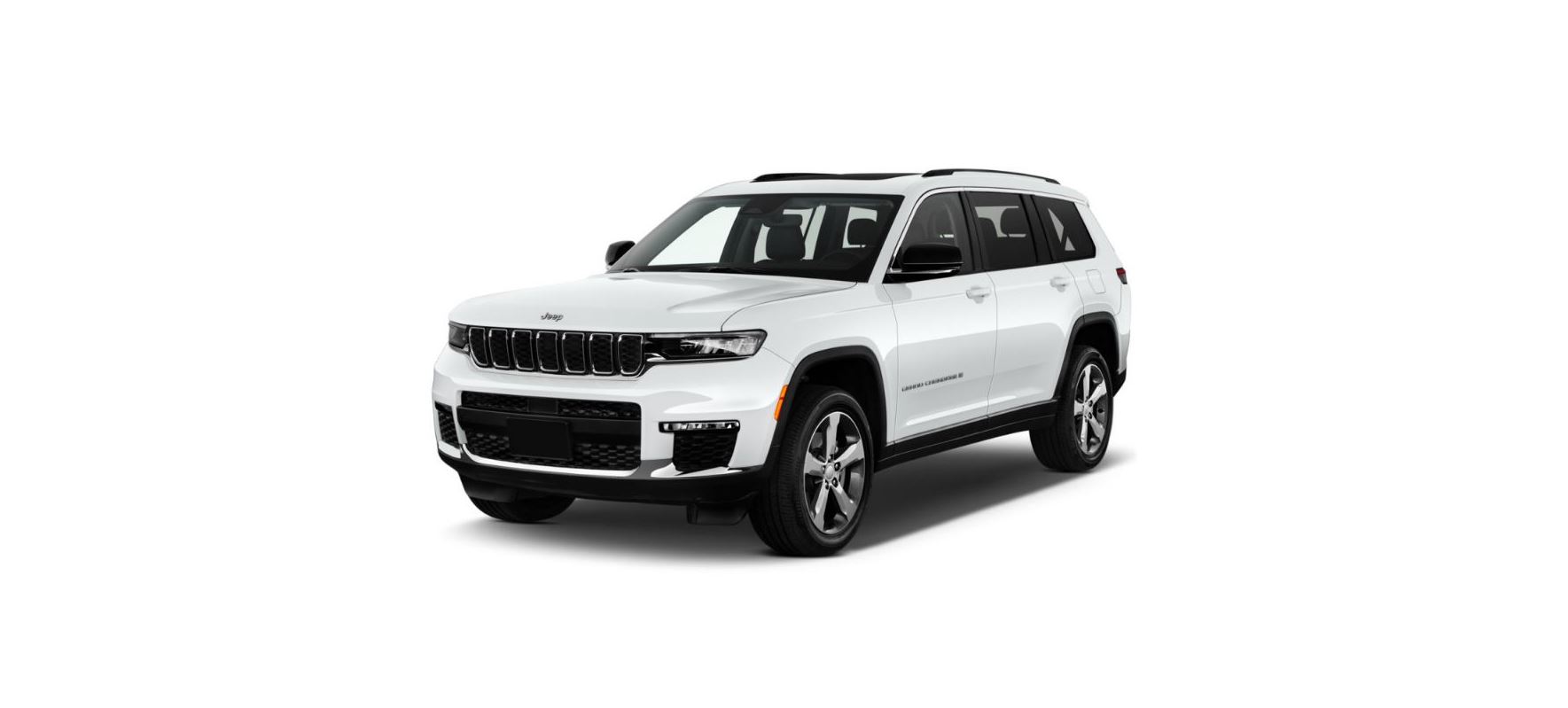2022 Jeep Grand Cherokee Liftgate User Guide

LIFTGATE
TO UNLOCK/OPEN THE LIFTGATE
 The power liftgate may be opened by pushing the liftgate button on the key fob or by pushing the electronic liftgate release button. Push the liftgate button on the key fob twice within five seconds to open the power liftgate. Once the liftgate is open, pushing the button twice within five seconds a second time will close the liftgate.
The power liftgate may be opened by pushing the liftgate button on the key fob or by pushing the electronic liftgate release button. Push the liftgate button on the key fob twice within five seconds to open the power liftgate. Once the liftgate is open, pushing the button twice within five seconds a second time will close the liftgate.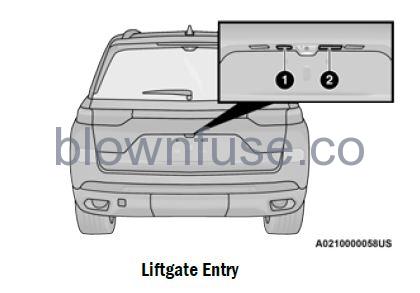
- Passive Entry Button
- Electronic Liftgate Release Button
NOTE: When you push the electronic liftgate release button, either only the liftgate will unlock, or all the doors and the liftgate will unlock, depending on the selected setting in the Uconnect system page 204.
NOTE
- Use the power door lock switch on either the front door trim panel or the key fob to lock and unlock the liftgate.
- The driver’s door lock cylinder will not lock or unlock the liftgate.
WARNING
Driving with the liftgate open can allow poisonous exhaust gases into your vehicle. You and your passengers could be injured by these fumes. Keep the liftgate closed when you are operating the vehicle.
NOTE: The liftgate can also be opened manually by pushing the electronic liftgate release button and pulling upward in one fluid motion.
TO LOCK/CLOSE THE LIFTGATE
There are several different ways to close the liftgate:
- Manually (grab the liftgate closing handle and pull in a downward motion)
- Key fob
- Hands-free (if equipped)
- Liftgate close button in the cargo area
With a valid Passive Entry key fob within 5 ft (1.5 m) of the liftgate, pushing the Passive Entry button located to the left of the electronic liftgate release button will lock the vehicle only.
If the liftgate is fully open, the liftgate can be closed by pushing the liftgate close button located in the cargo area on the left rear trim panel, near the liftgate opening. If the liftgate is in motion, pushing the liftgate close button a second time will reverse the liftgate operation.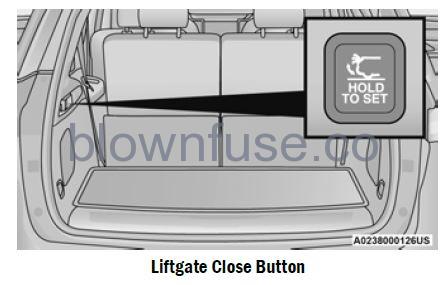
ADJUSTABLE POWER LIFTGATE HEIGHT
The maximum height that the liftgate will open can be adjusted and saved so that the liftgate will only open to the desired height. To set the desired height, proceed as follows:
- Open the liftgate fully, then manually pull down on the liftgate to the desired height.
- Push and hold the liftgate close button, located on the left side trim panel inside the cargo area, for three seconds. An audible chime will be heard to let you know the height has been saved.
To set the saved height setting to a new setting, proceed as follows
- Open the liftgate, then manually push the liftgate upward to its fully open position.
- Manually pull the liftgate down to the new desired height and hold the liftgate close button for three seconds until the audible chime is heard.
Power Liftgate Malfunction Procedure
- In the event of a power malfunction to the liftgate, the liftgate can be released by accessing the service release feature in the latch. This can be done using a 3 mm diameter screwdriver.
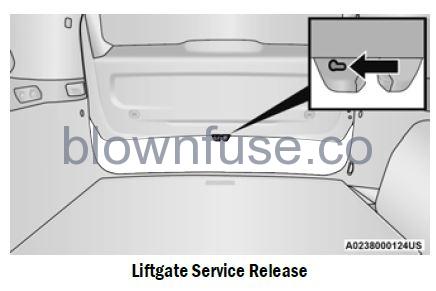
- From inside the gate, an eyelet can be seen. Place the screwdriver in the eyelet.
- Rotate the screwdriver handle to actuate the lever and release the latch.
- If the liftgate is left open for an extended period of time, the liftgate may need to be closed manually to reset the power liftgate functionality.
HANDS-FREE LIFTGATE — IF EQUIPPED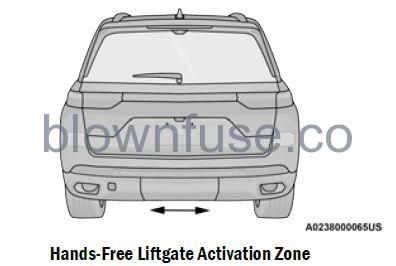
To open or close the liftgate using hands-free activation, use a straight in and out kicking motion under the vehicle activation zone in the general location below the rear license plate. The activation zone is about 1.8 ft (0.5 m) from side to side. Do not move your foot sideways or in a sweeping motion or the sensors may not detect the motion.
NOTE: The activation zone is the same for vehicles equipped with or without a trailer tow package.
When a valid kicking motion is completed, the liftgate will chime, the hazard lights will flash and the liftgate will open after approximately one second, or close after approximately three seconds. These settings can be enabled or disabled through Uconnect Settings page 204.
NOTE
- Opening or closing the Hands-Free Liftgate requires a valid Passive Entry key fob within 5 ft (1.5 m) of the liftgate handle. If a valid Passive Entry key fob is not within 5 ft (1.5 m), the lift-gate will not respond to any kicks.
- The Hands-Free Liftgate feature may be turned on or off through the Uconnect system on page 204.
- The Hands-Free Liftgate feature should be turned off during jacking, tire changing, manual car wash, and vehicle service.
- The Hands-Free Liftgate feature can be activated by any metallic object making a similar in-and-out motion under the rear fascia/bumper, such as cleaning using a metal broom.
- The Hands-Free Liftgate will only operate when the transmission is in PARK.
- If anything obstructs the Hands-Free Liftgate while it is opening or closing, the liftgate will automatically reverse to the closed/open position, provided it meets sufficient resistance.
- There are pinch sensors attached to the side of the liftgate opening. Light pressure anywhere along these strips will cause the liftgate to return to the open position.
- If the power liftgate encounters multiple obstructions within the same cycle, the system will automatically stop. If this occurs, the liftgate must be operated manually.
- The power liftgate will release, but not power open, in temperatures below −12°F (−24°C). Be sure to remove any buildup of snow or ice from the liftgate before opening the liftgate.
- If the liftgate is left open for an extended period of time (approximately one hour), the liftgate may need to be closed manually to reset the power liftgate functionality.
WARNING
- Driving with the liftgate open can allow poisonous exhaust gases into your vehicle. You and your passengers could be injured by these fumes. Keep the liftgate closed when you are operating the vehicle.
- If you are required to drive with the liftgate open, make sure that all windows are closed, and the climate control blower switch is set at high speed. Do not use the recirculation mode.
Gas props support the liftgate in the open position. However, because the gas pressure drops with temperature, it may be necessary to assist the props when opening the liftgate in cold weather.
NOTE: Allow the power system to open the liftgate. Manually pushing or pulling the liftgate may activate the liftgate obstacle detection feature and stop the power operation or reverse its direction.
WARNING
During power operation, personal injury or cargo damage may occur. Ensure the liftgate travel path is clear. Make sure the liftgate is closed and latched before driving away.
CARGO AREA FEATURES
Cargo Storage
- The load floor is designed for a maximum load of 300 lb (136 kg).
- There is a removable storage bin located on the left side of the rear cargo area.
Additional storage can be found under the storage lid. To access the lower storage, lift the handle and raise the storage lid.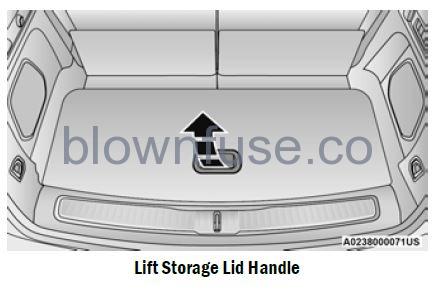
Cargo Tie-Down Hooks
The cargo tie-downs, located on the cargo area sides, should be used to safely secure loads when the vehicle is moving.
NOTE: The cargo tie-downs are designed for a maximum load of 300 lb (136 kg).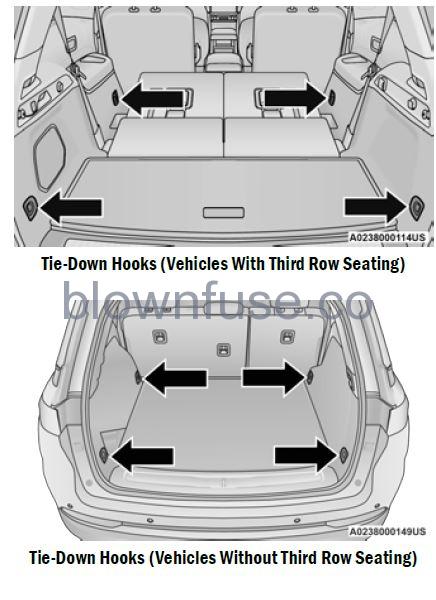
WARNING
- Cargo tie-downs are not safe anchors for a child seat tether strap. In a sudden stop or accident, a tie-down could pull loose and allow the child seat to come loose. A child could be badly injured. Use only the anchors provided for child seat tethers.
- To help protect against personal injury, passengers should not be seated in the rear cargo area. The rear cargo space is intended for load carrying purposes only, not for passengers, who should sit in seats and use seat belts.
The weight and position of cargo and passengers can change the vehicle’s center of gravity and vehicle handling. To avoid loss of control resulting in personal injury, follow these guidelines for loading your vehicle:
- Do not carry loads that exceed the load limits described on the label attached to the left door or left door center pillar.
- Always place cargo evenly on the cargo floor. Put heavier objects as low and as far forward as possible.
WARNING
- Place as much cargo as possible in front of the rear axle. Too much weight or improperly placed weight over or behind the rear axle can cause the vehicle to sway.
- Do not pile luggage or cargo higher than the top of the seatback. This could impair visibility or become a dangerous projectile in a sudden stop or accident.
Retractable Cargo Area Cover — If Equipped
The purpose of this cover is for privacy, not to secure loads. It will not prevent cargo from shifting or protect passengers from loose cargo. To cover the cargo area:
- Grab the cover at the center handle and pull over the cargo area.
- Insert the pins on the ends of the cover into the slots in the pillar trim cover.
- The liftgate may be opened with the cargo cover in place.
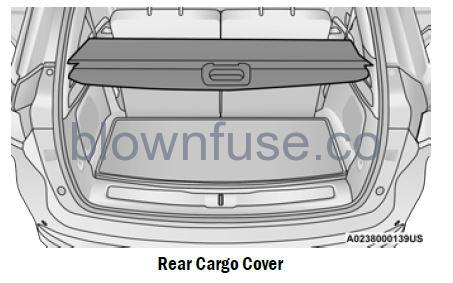
WARNING
In a collision, a loose cargo cover in the vehicle could cause injury. It could fly around in a sudden stop and strike someone in the vehicle. Do not store the cargo cover on the cargo floor or in the passenger compartment. Remove the cover from the vehicle when taken from its mounting. Do not store it in the vehicle.
Foldable Cargo Area Cover — If Equipped
The purpose of this cover is for privacy, not to secure loads. It will not prevent cargo from shifting or protect passengers from loose cargo.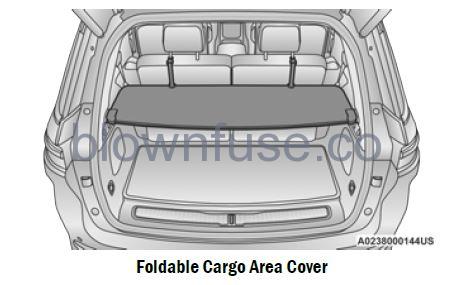
To cover the cargo area:
- Remove the folded cover from the storage pouch, and unfold using a twisting motion.
- Insert the pins on the ends of the cover into the slots on each side of the pillar trim.
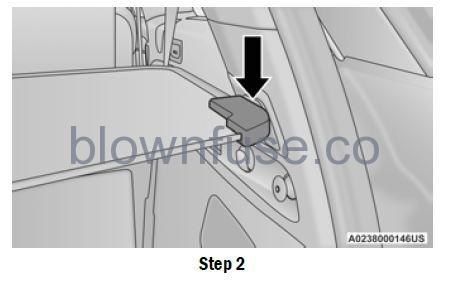
- Hook the straps to the outside post of the rear head restraint on each side.
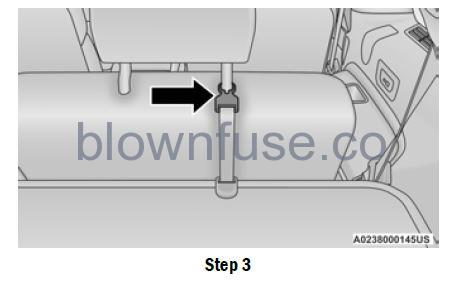
NOTE: The liftgate may be opened with the cargo cover in place.
To store the foldable cargo area cover, reverse the installation steps and replace the cover with its storage pouch.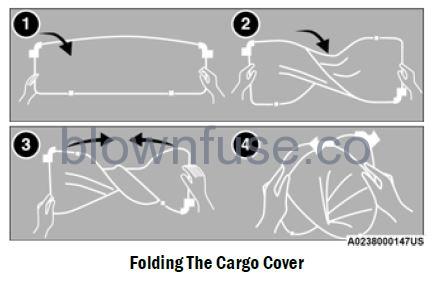
- Remove Cover From Vehicle
- Twist Cover
- Push Twisted Cover Inward
- Place Folded Cover In Pouch
WARNING
In a collision, a loose cargo cover in the vehicle could cause injury. It could fly around at a sudden stop and strike someone in the vehicle. Do not store the cargo cover on the cargo floor or in the passenger compartment. Remove the cover from the vehicle when taken from its mounting. Do not store it in the vehicle.
